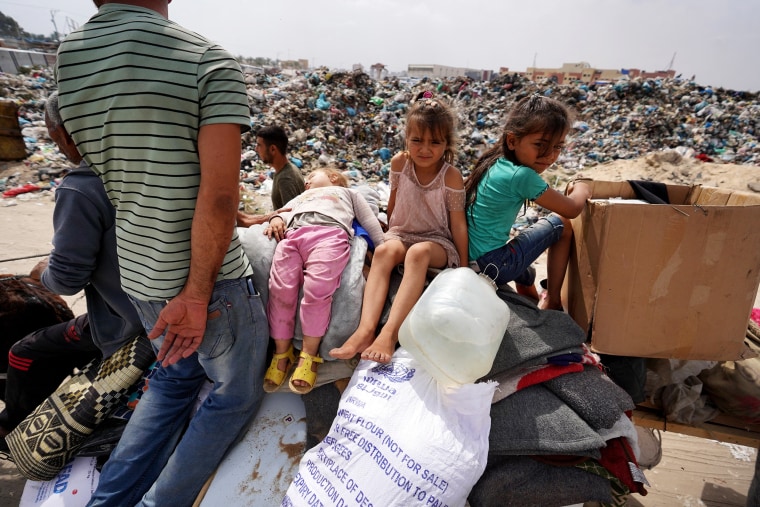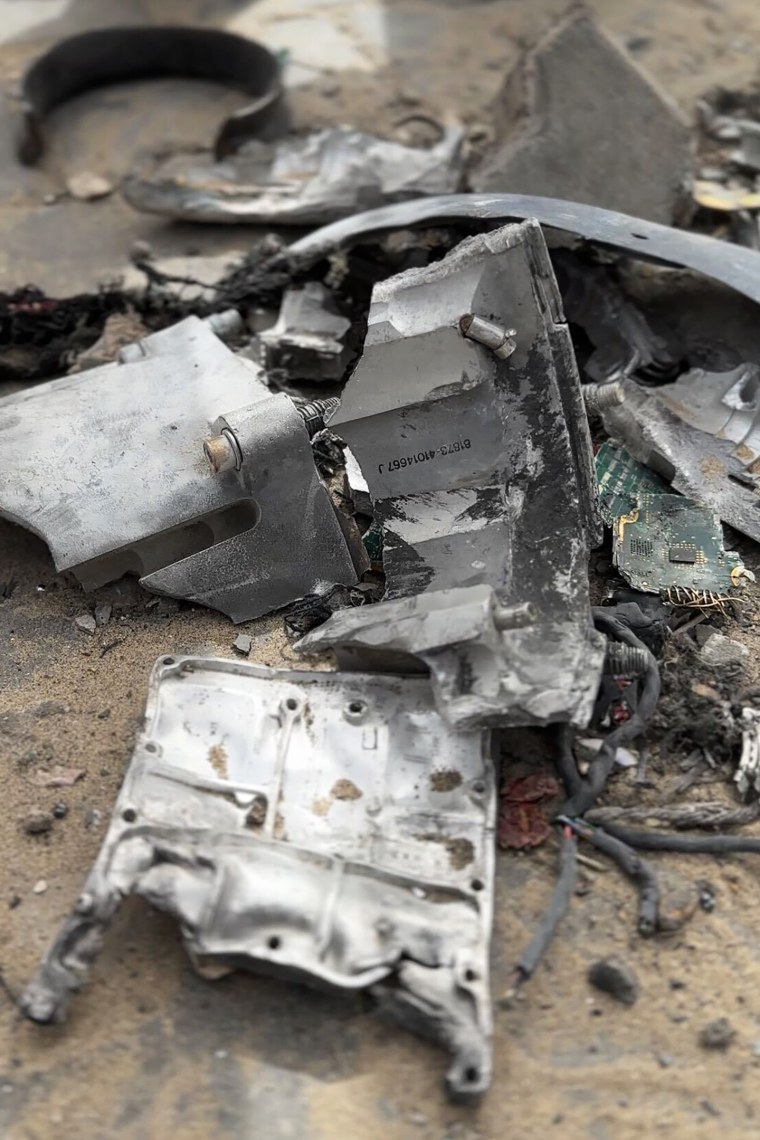What we know about Israeli strike on a tent camp in Rafah
Some people there interviewed by NBC News said they had been displaced from other parts of Gaza. UNRWA, the U.N. agency supporting Palestinian refugees, said it was not involved in the setup of the tent camp.
On the night of the strike on May 26, one mother said she was getting her children’s beds ready for the family to go to sleep. The woman, who declined to provide her name, said she was giving medicine to a sick child when she heard a loud and “abnormal” sound.
“I suddenly saw the place on fire,” she told NBC News’ crew on the ground on May 27, the day after the attack. “All the people fled from the tents running. The sound was horrifying and deafening.”
Abou Tarek Elkaferna, who said he and his family had fled from northern Gaza to Rafah, was also there.
“It was terrifying for the children,” he said. “Civilians, sitting in God’s safety and suddenly the shelling occurred with massive explosions.”
Alam Sadeq was about a half-mile away when he said he heard a “massive explosion” and then saw “the place catch on fire.”
The 35-year-old journalist said he did not go toward the blaze until the next day out of fear of further blasts.
An NBC News team reporting in Gaza said they had heard multiple explosions at around 8:45 p.m. that evening. They raced to the scene alongside an ambulance crew, where they found the tent camp engulfed in flames as residents sought to put the fire out and help the injured.
It took first responders and residents about 45 minutes to extinguish the blaze, Muhammad Al-Mughir, a spokesperson for Gaza’s Civil Defense, told NBC News.
A scorched area visible in satellite images from Planet Labs the day after the strike appears to be about 110 feet long and 53 feet wide. The images appear to show at least five structures burnt to the ground.
“The fire was huge” and most of the people killed “died by burning,” Al-Mughir said.
MSF said its staff treated 180 injured people nearby, mostly suffering shrapnel wounds, fractures and severe burns.
“Blood was everywhere,” Sadeq said of the following day when he went to the site. He shared photos that appeared to show people searching through sand spattered with blood.
The Israeli military said it was targeting senior Hamas leaders responsible for organizing attacks in the occupied West Bank when it launched its strike on “a compound” in Tal al-Sultan.
The resulting fire that tore through the encampment was “unexpected and unintended,” Israel Defense Forces spokesman Rear Adm. Daniel Hagari said. Intelligence used by the Israeli military indicated there were “no tents in the immediate vicinity” of the structure they targeted, he added.
The IDF released a satellite image showing the distance between the point of the strike and a U.N. compound some 600 feet away.
But satellite imagery captured hours before the strike by Planet Labs and reviewed by NBC News appears to show the tents and other temporary structures clustered around the site of the bombing, raising questions about the IDF’s assessment.
Asked to comment on the fact that structures housing civilians may have been much closer to the IDF’s target, and whether the Israeli military was aware of that before launching its strike, an IDF spokesperson told NBC News: “We stand by our initial statement.”
The IDF fired two 17-kilogram (37.5-pound) warheads, Hagari said, adding that the bombs were the “smallest munition that our jets can use.”
Weapons experts and human rights advocates said the IDF should have been aware of the potential risks.

James Cavanaugh, a former specialist with the Bureau of Alcohol, Tobacco, Firearms and Explosives, told NBC News that while 37.5-pound warheads “may be the smallest bomb” the Israeli military has, “it’s not small. To compare, an anti-tank mine is 10 to 30 pounds of explosives.”
A 37-pound bomb has a fragment radius of at least 40-50 yards, which means that flammable parts of the munition can travel those distances and potentially start fires.
Retired U.S. military Col. Jack Howard Jacobs, a military analyst for NBC News, said the munition used may not “sound like very much, but it’s a great deal, especially in an environment in which there’s a large population of civilians in the area.”
The IDF should have planned for the possibility of a scenario in which a fire might break out — as well as for the potential risk of its strike to any civilians nearby, Cavanaugh said.
Explosive weapons expert Chris Cobb-Smith also said the IDF should have considered the risks of its deployment, even if using precision bombs like the GBU-39.
“Designed to attack strategically important point targets, its limited blast should reduce collateral damage,” Cobb-Smith said.
But “using any munition, even of this size, will always incur risks in a densely populated area,” he added.
Hagari said the fire could have been ignited if the IDF hit weapons that might have been stored beside the compound it targeted. He said the IDF made that “assumption” after it intercepted a call the military said was between “two Gazans.”
Cavanaugh said that if there was a cache of weapons near the target, it’s unlikely to have been a large one as the blaze did not indicate “some giant stash that exploded.”

He said a number of things might have ignited and possibly further spread the blaze, while Jacobs said that anywhere there is a civilian population, there is likely to be “flammable material.”
Jacobs said the main issue should not be whether or not there was flammable material and gas tanks or canisters near the Israeli military’s target.
“My consideration would be the concentration of people who are not combatants,” he said.
Bill Van Esveld, a Human Rights Watch expert on the region, said it was “hard to say” at this point why exactly the IDF appeared to have failed to identify the risks associated with its attack.
But he said his organization had documented a “pattern of Israeli forces launching attacks that killed large numbers of civilians where it was clearly in violation of the laws of war.”
Confusion and fear
The events of May 26 highlight the confusion Palestinians in Gaza face while deciding where is “safe.”
Hagari said that the IDF’s strike was just under a mile away from the “humanitarian area” in nearby Muwasi that the Israeli military advised those evacuating Rafah to move to. He said the IDF considers Muwasi a “safer zone,” using a term the Israeli military has previously used to describe humanitarian zones.
Survivors of the blaze told NBC News they had believed they were inside the “safe” zone, however. And speaking in the aftermath of the strike, Gaza Civil Defense spokesman Muhammad Al-Mughir said his team had also believed the tent camp was in a “humanitarian area” since it was not far from United Nations warehouses.
An NBC News analysis of the IDF’s maps showing “safer” areas in Gaza shows the Tal al-Sultan encampment did not appear to be in either a designated humanitarian area or an area under direct evacuation orders issued in early May.
Asked about whether the military had issued any further orders for the site of the strike before it was attacked, an IDF spokesperson said that it had been “imploring” civilians to “temporarily evacuate from areas of intense fighting” since the start of the war.
They added that they used radio broadcasts, an Arabic website, “millions of prerecorded phone calls and thousands of live phone calls” to disseminate this information along with millions of leaflets.
The spokesperson did not say whether evacuation orders had been issued for the exact site of the strike.
Van Esveld, from Human Rights Watch, told NBC News in a phone interview Friday he had also heard that “people were confused” about whether the area was a safe zone.
He said the IDF’s evacuation orders and warnings for civilians have “consistently fallen short of the minimum international standards.” Even if civilians had been warned ahead of the strike, the Israeli military still has a responsibility to avoid bringing harm to civilians, he added.
“Just because you order an evacuation,” Van Esveld said, “doesn’t give you carte blanche to launch these attacks.”





